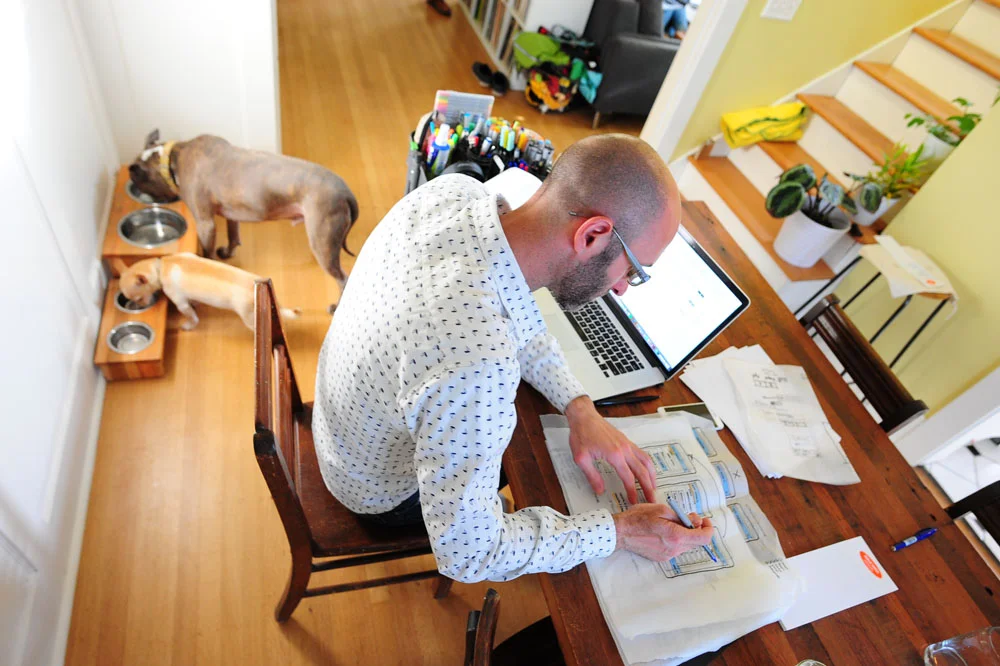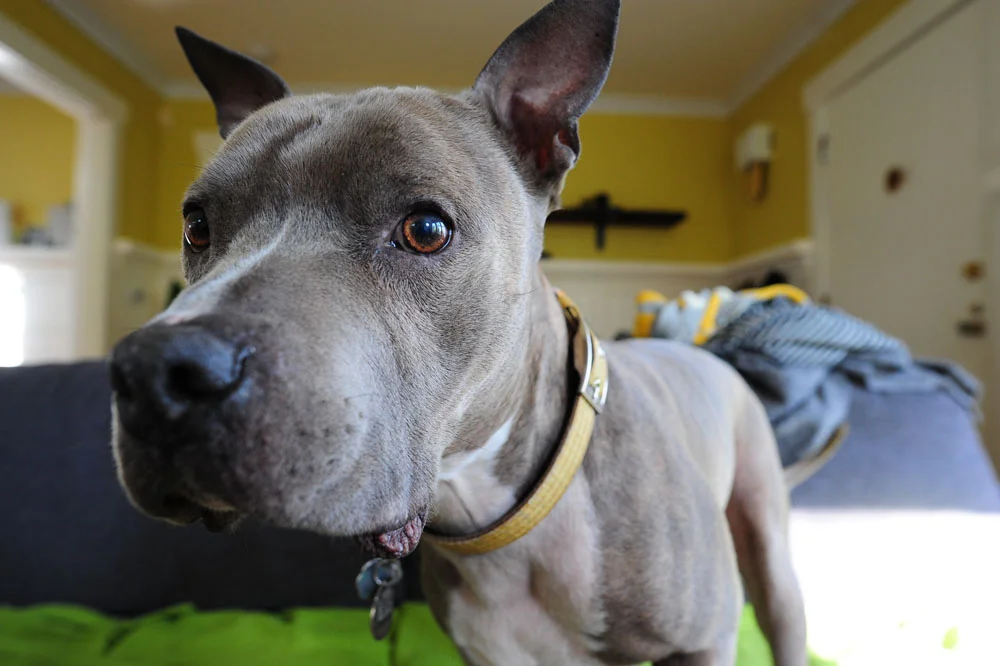About
I grew up in the Pacific Northwest and really can't imagine any place better. I enjoy playing outside, playing guitar, DJ'ing electronic music, designing and building, beekeeping and hanging out with my wife Stacy and our dogs Banjo and Watson. I have a sarcastic sense of humor and enjoy annoying the hell out of my wife. I am constantly singing songs about our dogs and giving them new nicknames. I prefer to enjoy life and pride myself in being able to talk with anyone about anything.
I started problem solving in the field of construction, which later became a career in architecture and design. There is a part of me that is always looking to improve myself and continue to learn new things at every turn. I am very excited about the future of UX design. Contact me and I can tell you more...
Tell us a bit about the work you’re doing right now.
Currently, I’m working on a security related product for a startup here in Seattle. The product enables companies with large security risk to allow their employees to browse the internet without worry of malware and other malicious content. The product also provides anonymity and privacy for the users. We don’t log any data on our users, and our admin tool doesn’t keep user emails. You can go anywhere you want on the internet safely and anonymously, so long as you don’t give the sites any information. It’s been a steep learning curve, but an exciting journey.
Previously you were in an architectural designer’s role. What made you make that move?
I think this came from a Hemingway novel and describes most things in life well. Slowly at first, then all at once. I had been questioning for a long time if architecture was what I wanted to do for the rest of my life and realized that I wanted to push myself further and try something new. I was nearing the point where I needed to get my license, or move on and try something else. My wife had been working in a UX role for a few years, and I took an interest in the fast, iterative, and research-based process. I joined a three-month boot camp to see if I would enjoy it and loved it! I quit my job half way through and concentrated on building up my skill set and portfolio.
How did you end up in your current role?
It was really by chance that it happened. An ex-colleague called me and asked me to take a tour of a local startup incubator. She was looking to start an incubator and knowing that I had recently made the switch from architecture to product design she figured she could pick my brain a bit. The tour guide happened to be a friend of another ex-colleague and a city planner, so we instantly hit it off. I told him of my recent move to product design, and he set me up with Weblife.
During the interview, the CPO asked why he should ever consider hiring me. It was a reasonable question since I had little to zero product design experience. I took him through an average day in the life of an architect; all the complexities of dealing with clients, consultants, agencies, codes, and laws, all while trying to make beautiful spaces. He was convinced I could tackle new and complex problems and hired me on the spot.
What would you say are the most challenging aspects of the work you do right now?
Being the only designer has been difficult. I was lucky enough to have a PM that understood UX, but it’s nice to have a team of designers to bounce ideas off. The complexity of security products can be daunting, so I am always learning new things every day. The most challenging aspect is that I am responsible for the company-wide design that includes: digital products, research, branding and design presence, product voice and marketing materials to name a few. Working in a small startup meant I had to perform numerous tasks. It makes you feel important but can drain you and take your attention away from the actual products.
When you're faced with something that's unfamiliar to you, or that you haven’t done before, what is your process for approaching that?
I like to sit down and set the table before I even think of a solution. I want to take the problem apart and be able to put it back together. This process usually starts by researching, talking to users and covering all the edge cases that might come up. As a product designer, I feel it is important to approach design problems from the point of empathy. After I understand the problem from multiple viewpoints, then I can start thinking of possible solutions. I figure it’s good to work on things you aren’t familiar with, as you can leave bias on the table and possibly give a new and fresh perspective, as a fresh set of eyes sees the typo others had glazed over in their earlier attempts.
Are there any specific techniques that you use in terms of routines or processes that help you accomplish everything that you need to do in a day or a week?
I’ve learned over time that small, measurable goals are the key to accomplishing what you want, all while keeping your head straight. Take the larger tasks and break them down into manageable sizes. There is nothing worse than looking at the same uncompleted task sitting there on your to-do list. Secondly, I take a small chunk of time every day to perform project management and try not to clutter up my work day too much. If I look at my calendar and it looks like a meeting color explosion then I know I’m not going to be successful. I prefer to see some large sections of color with the words “heads down design work.” You can use all the tools in the world, but if you can’t figure out these fundamentals, you will never get there. I have never met an excellent multitasker, but rather great planners and managers of time.
What would you say are the tools you're using on a daily basis?
- Todoist - Managing smaller tasks
- Github (Zenhub) - Managing the development process
- Google Hangouts - Vital for staying in contact with a remote team. Pick up the phone!
- Google Calendar - Time tracking and meetings.
- Slack - For communicating with my team.
- Sketch - For static designs it is an elegant tool.
- Invision - Share specs with Inspect and new designs.
- Adobe Suite - I mostly use Illustrator for vector graphics and icons.
- My devices - I have a Laptop, Ipad, Android phone and an Iphone 7 to test screens on.
- Pen and Paper - I can’t stare at the screen all day.
What are the tools you don’t use on a daily basis that you can’t live without?
- Origami Studio by Facebook - I use this to explore interaction design and animation.
- Screenflow - This is great for recording remote usability tests.
- Usability Hub - I use this web based tool for surveying and preference tests.
Do you ever experience burnout and how you manage that? How you keep yourself motivated and going on multiple different things?
Of course. Who doesn’t? It’s not a matter of if, it’s when. If possible, I like to set it down and work on something else. One of my biggest releases is playing music. I can spin a house set for lunch, or work on a new song on guitar. Nothing settles my mind better.
Burnout is also a great reason to have a strong balance between work and life. A person who has time to come home, make dinner and hang out with the family is a more efficient and happy designer.
Why do you do what you do? What makes working in design so meaningful to you and why do you enjoy it?
I enjoy designing and making things. Exploring new and complex problems is fascinating and rewarding. I grew up in a rural area and have always had to create my fun and solve my problems with what I had on hand. My construction experience taught me how to build things with my hands. My architectural experience taught me how to design those things to be better for the world, and its inhabitants. Now I get to explore how the digital and physical world collide. I couldn’t think of anything more exciting as we enter a new age.






